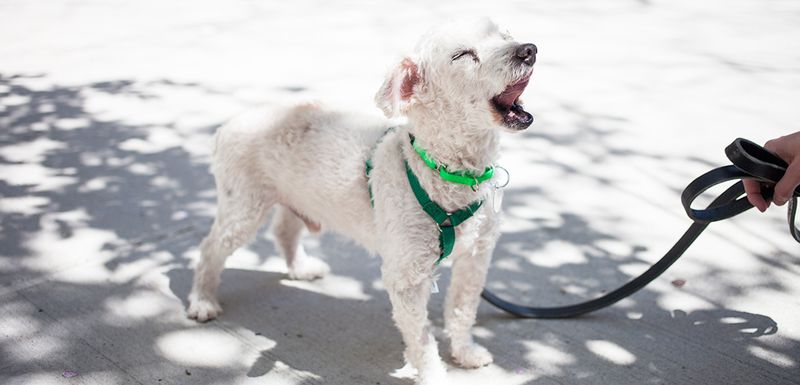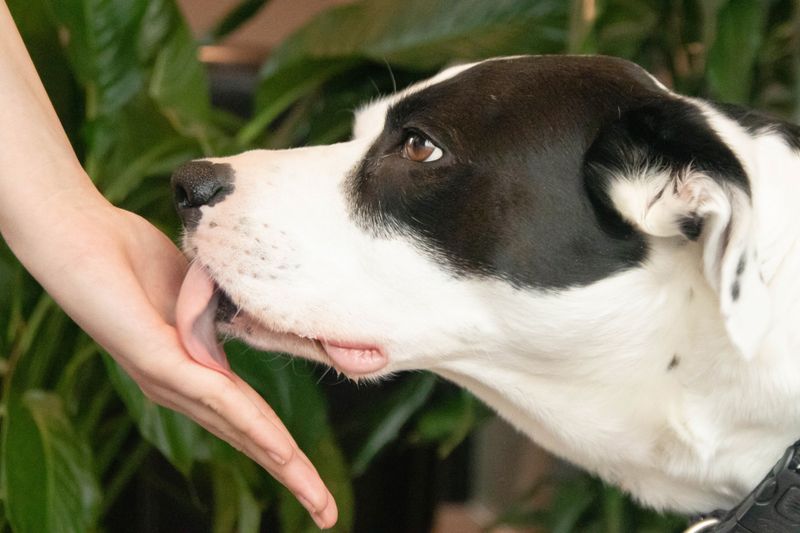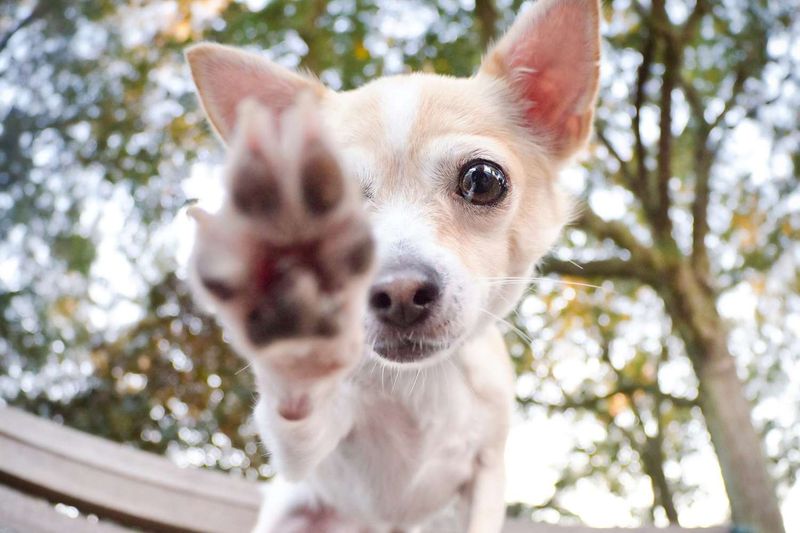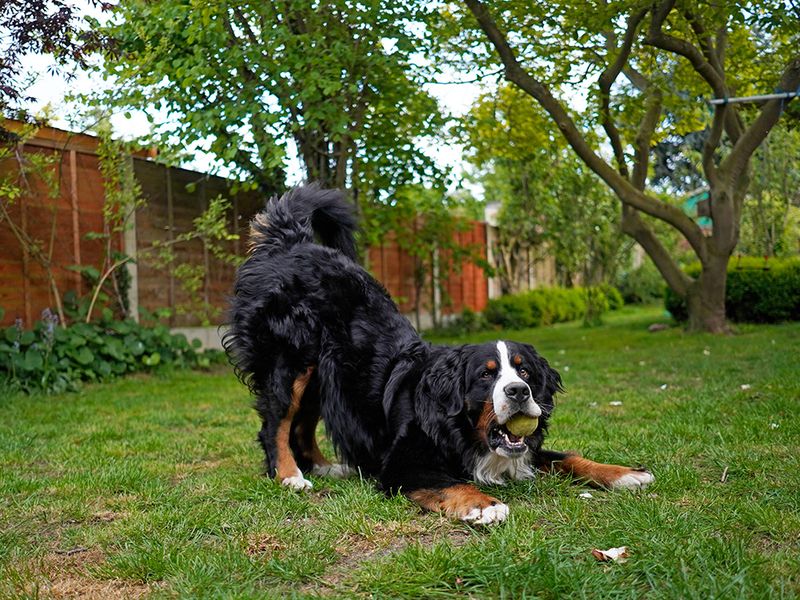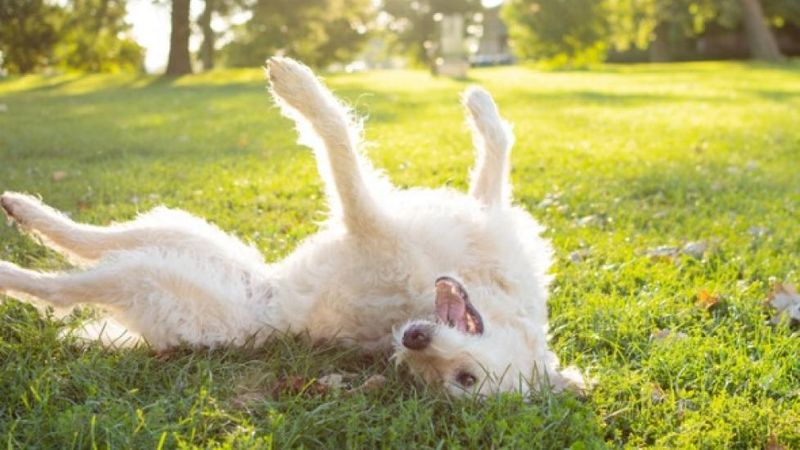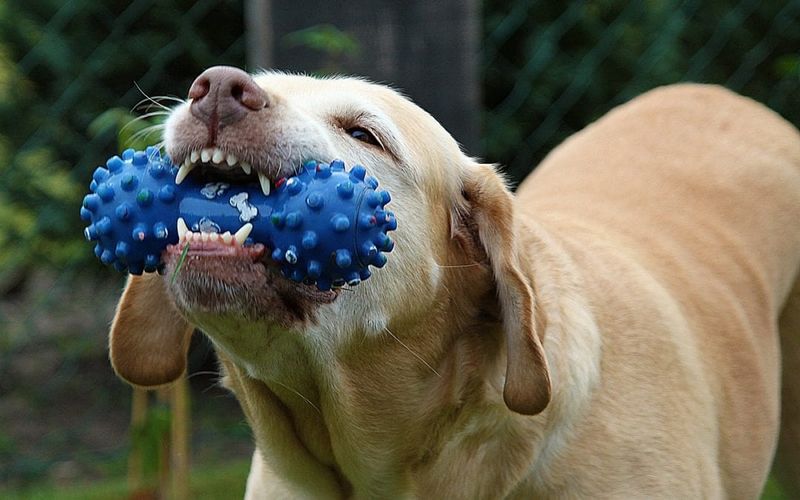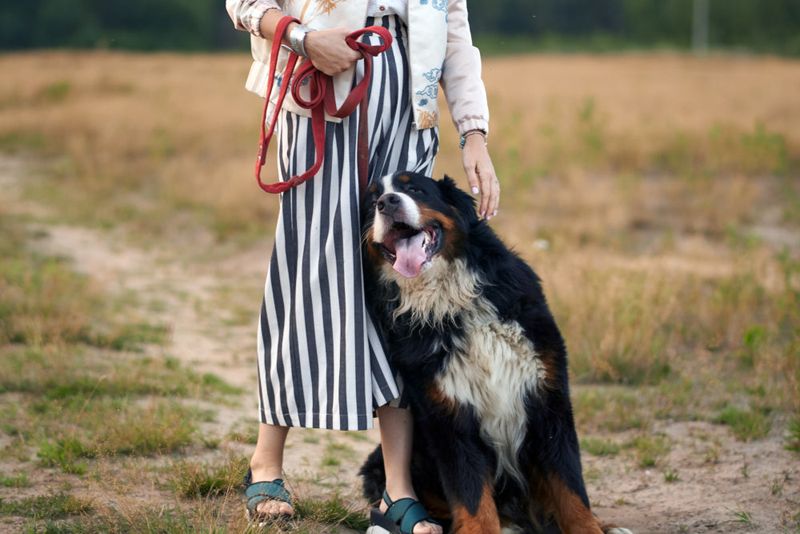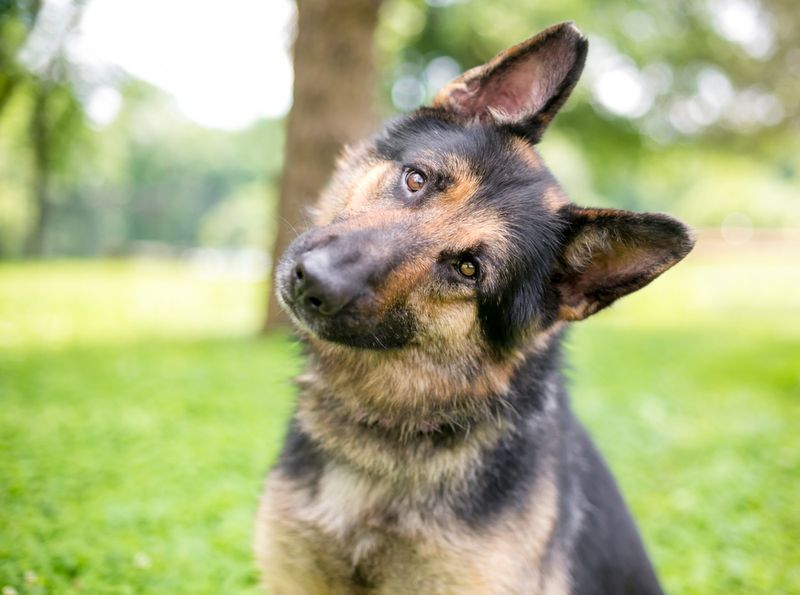Dogs have an amazing ability to communicate with humans through subtle yet telling gestures and actions. By understanding these signals, we can deepen our relationship with our furry friends and respond better to their needs. Here are 21 ways your dog tries to tell you something, uncovering the hidden messages behind those wagging tails and soulful eyes.
Tail Wagging
When your dog wags its tail, it’s not just a sign of happiness. Tail wagging can indicate a range of emotions, from excitement to anxiety. The speed and direction of the wag can give you clues about what your dog is feeling. A fast, wide wag usually means your dog is happy to see you, while a slow wag with a neutral position might show insecurity. By paying attention to these nuances, you can better understand your dog’s emotional state and respond accordingly. Remember, tail wagging is a language that needs to be read in context.
Barking
Barking is one of the primary ways dogs communicate, but not all barks are created equal. Dogs bark to alert you of potential danger, express excitement, or even when they’re bored and seeking attention. The pitch, frequency, and duration of the bark can provide insights into what your dog is trying to say. For instance, a high-pitched, continuous bark might indicate excitement, while low, repetitive barks could be a warning. Understanding this vocalization can help you decipher whether your furry friend wants to play or has spotted something unusual.
Licking
Licking is a multifaceted form of communication for dogs. It can be a sign of affection, a way to comfort themselves, or a method to get your attention. When your dog licks you, it’s often showing affection and bonding, much like how they would with their pack in the wild. However, excessive licking can also indicate anxiety or stress. Paying attention to the context and frequency of your dog’s licking can help you determine if they’re feeling content or if they’re trying to soothe themselves from discomfort.
Ear Position
The position of your dog’s ears can reveal a lot about their mood and intentions. Ears that are perked up and facing forward typically indicate curiosity or alertness, while ears that are laid back might signify fear or submission. By observing your dog’s ear position in different situations, you can gain insight into their emotional state. This understanding allows you to respond appropriately, whether it’s by providing reassurance or engaging in play. Your dog’s ears are like antennas, constantly picking up signals from their environment and conveying subtle messages to you.
Yawning
Yawning in dogs is more than just a sign of tiredness. It can be a way to release tension or express stress and anxiety. In some cases, dogs may yawn in response to a new environment or unfamiliar people, attempting to calm themselves. Observing when and how often your dog yawns can provide valuable insights into their comfort levels. By recognizing this behavior, you can help create an environment where your dog feels more secure and at ease. So, next time your dog yawns, consider if they’re sleepy or if they might need a comforting pat.
Whining
Whining is a common communication tool for dogs, often indicating a need or desire. Whether your dog is seeking attention, expressing hunger, or feeling anxious, whining can convey a multitude of messages. It’s essential to pay attention to the context and accompanying body language to interpret this vocalization accurately. For example, whining with a wagging tail might suggest excitement, while whining with ears laid back could indicate discomfort. By understanding what your dog is trying to express, you can address their needs and provide the appropriate support and comfort.
Pawing
When your dog paws at you, it’s not just seeking attention. This gesture can signify a need for physical contact, a request for play, or an attempt to comfort you. Dogs may use their paws to communicate a variety of messages, depending on the situation. For instance, a gentle pawing might be a request for a belly rub, while more insistent pawing could be a sign of anxiety or a need for reassurance. By observing the context and accompanying behaviors, you can better understand what your dog is trying to tell you with its paws.
Eye Contact
Eye contact between you and your dog can be a powerful form of communication. Maintaining eye contact often signifies trust and affection, strengthening the bond between you. However, direct eye contact can also be perceived as a challenge or threat, depending on the context and your dog’s temperament. It’s important to read the situation and your dog’s body language to interpret eye contact correctly. By understanding the nuances of this form of communication, you can foster a deeper connection with your furry friend and ensure they feel safe and understood.
Play Bow
The play bow is a universal signal dogs use to invite playtime and fun. When your dog stretches its front legs forward and lowers its chest to the ground, it’s communicating a desire to engage in playful interaction. This gesture is often accompanied by a wagging tail and a relaxed demeanor. Recognizing the play bow can help you understand when your dog is in the mood for some lively activity, allowing you to join in the fun or facilitate interactions with other dogs. This playful posture is a clear indicator of your dog’s joyful spirit and eagerness to connect.
Rolling Over
When a dog rolls over, it’s often seen as an act of submission or a request for a belly rub. However, rolling over can also indicate trust and relaxation. By exposing their vulnerable belly, dogs show that they feel safe and comfortable in your presence. This gesture can be an invitation for petting or a playful act, depending on the situation. Understanding the context of your dog’s roll over behavior can help you respond with affection or engage in play, reinforcing the bond between you and your furry companion. It’s a delightful way to share in your dog’s contentment.
Chewing
Chewing is a natural behavior for dogs, serving various purposes from teething to stress relief. When your dog chews on toys, it can indicate boredom, anxiety, or simply a need to exercise their jaws. Providing appropriate chew toys can help satisfy this urge and prevent destructive behavior. Understanding why your dog is chewing enables you to address their needs effectively, keeping both their teeth healthy and your belongings safe. Remember, chewing is an instinctive way dogs explore their world and manage emotions, and with the right guidance, it can be a positive outlet for energy.
Howling
Howling is a primal form of communication, often used by dogs to express loneliness or respond to certain sounds. Originating from their wolf ancestors, dogs may howl to signal their presence or call out to others. Understanding the context of your dog’s howling can help you determine if they’re feeling isolated or reacting to environmental triggers. Engaging in interactive play or providing companionship can alleviate their need to howl. It’s a hauntingly beautiful reminder of your dog’s wild roots and an intriguing glimpse into their complex communication repertoire.
Digging
Digging is a natural instinct for many dogs, rooted in their hunting and burrowing ancestry. This behavior can indicate a variety of needs, from seeking comfort in cool earth to attempting to hide treasures. It’s also a way to alleviate boredom or stress. By providing designated digging areas or engaging your dog in interactive play, you can channel this instinct appropriately. Understanding your dog’s motivation for digging helps you address their needs and prevent garden havoc. It’s a fascinating behavior that highlights your dog’s innate skills and instincts.
Growling
Growling is a form of vocal communication that dogs use to express discomfort, fear, or aggression. It’s a warning signal that should be taken seriously, as it indicates that your dog feels threatened or uneasy. Understanding the context and body language accompanying a growl can help you address the underlying issue and prevent escalation. Respecting your dog’s boundaries and providing reassurance can help diffuse tense situations. Growling is not always a sign of aggression; it’s a way for your dog to communicate their feelings and boundaries clearly.
Panting
Panting is a normal behavior for dogs, primarily used to regulate body temperature. However, excessive panting can also indicate stress or overheating. Recognizing when your dog is panting from exertion versus anxiety can help you address their needs appropriately. Providing water and a cool environment can alleviate heat-related panting, while calming techniques can soothe stress-induced panting. Understanding the nuances of your dog’s panting helps ensure their comfort and well-being. It’s a vital way dogs communicate their physical state and an essential aspect of their overall health.
Leaning
When a dog leans against you, it’s often a sign of affection and trust. This gesture indicates that your dog feels secure and connected, seeking closeness and comfort. Leaning can also be a request for attention or support in uncertain situations. By leaning on you, your dog expresses their reliance on you as a source of reassurance. It’s a touching expression of companionship, revealing the deep bond you share. Recognizing and responding to this behavior strengthens your relationship, providing your dog with the emotional security they crave.
Sniffing
Sniffing is a crucial behavior for dogs, allowing them to explore and understand their environment. Through their highly sensitive noses, dogs gather information about other animals, people, and objects around them. Sniffing can also be a calming activity, helping dogs process new situations and reduce stress. Encouraging your dog’s natural inclination to sniff by providing varied environments and interactive scent games can enrich their experience. Understanding the importance of sniffing in your dog’s life helps you appreciate their world and the sophisticated ways they communicate through scent.
Backing Up
When a dog backs up, it often indicates caution or uncertainty. This behavior can be a response to unfamiliar objects, people, or situations. By observing when and why your dog chooses to back away, you can gauge their comfort levels and adjust their environment accordingly. Providing reassurance and allowing your dog to explore at their pace helps build confidence and trust. Recognizing this subtle form of communication enables you to support your dog in navigating the world with resilience and understanding.
Sneezing
Sneezing in dogs can be a form of communication, often used during play to signal excitement or break tension. Known as a play sneeze, it indicates that your dog is having fun and is not feeling threatened. Observing when your dog sneezes can provide insights into their comfort and enjoyment levels. Understanding this quirky behavior helps you interpret your dog’s playful intentions and foster a joyful environment. It’s a charming reminder of the unique ways dogs express themselves and connect with their human companions.
Head Tilting
Head tilting in dogs is an endearing behavior that often indicates curiosity or attentiveness. When your dog tilts its head, it’s trying to better understand what you’re saying or focusing on a new sound. This cute gesture enhances their ability to pick up on verbal cues and shows their interest in engaging with you. Responding to your dog’s head tilt with positive reinforcement encourages communication and strengthens your bond. It’s a delightful way dogs demonstrate their eagerness to connect and participate in your world.
Staring
When a dog stares at you, it’s often a sign of affection, attention, or a request. This behavior can be a way for your dog to express love, seek guidance, or signal a need such as hunger. By interpreting the context of your dog’s stare, you can respond appropriately, whether it’s by providing a treat or engaging in play. Understanding this form of communication enhances your relationship and ensures your dog feels heard and supported. Staring is a clear indication of your dog’s desire to connect and interact with you meaningfully.


